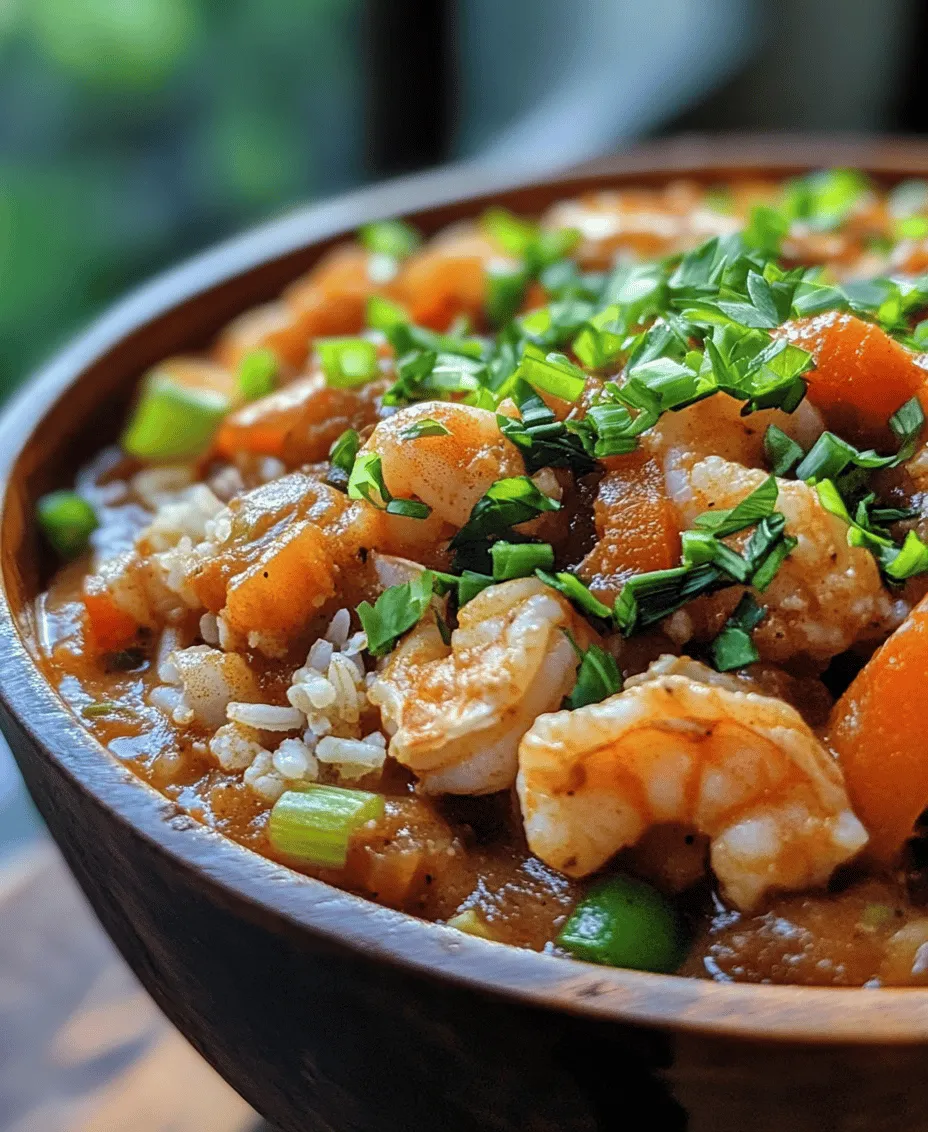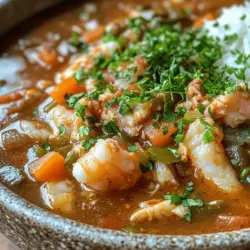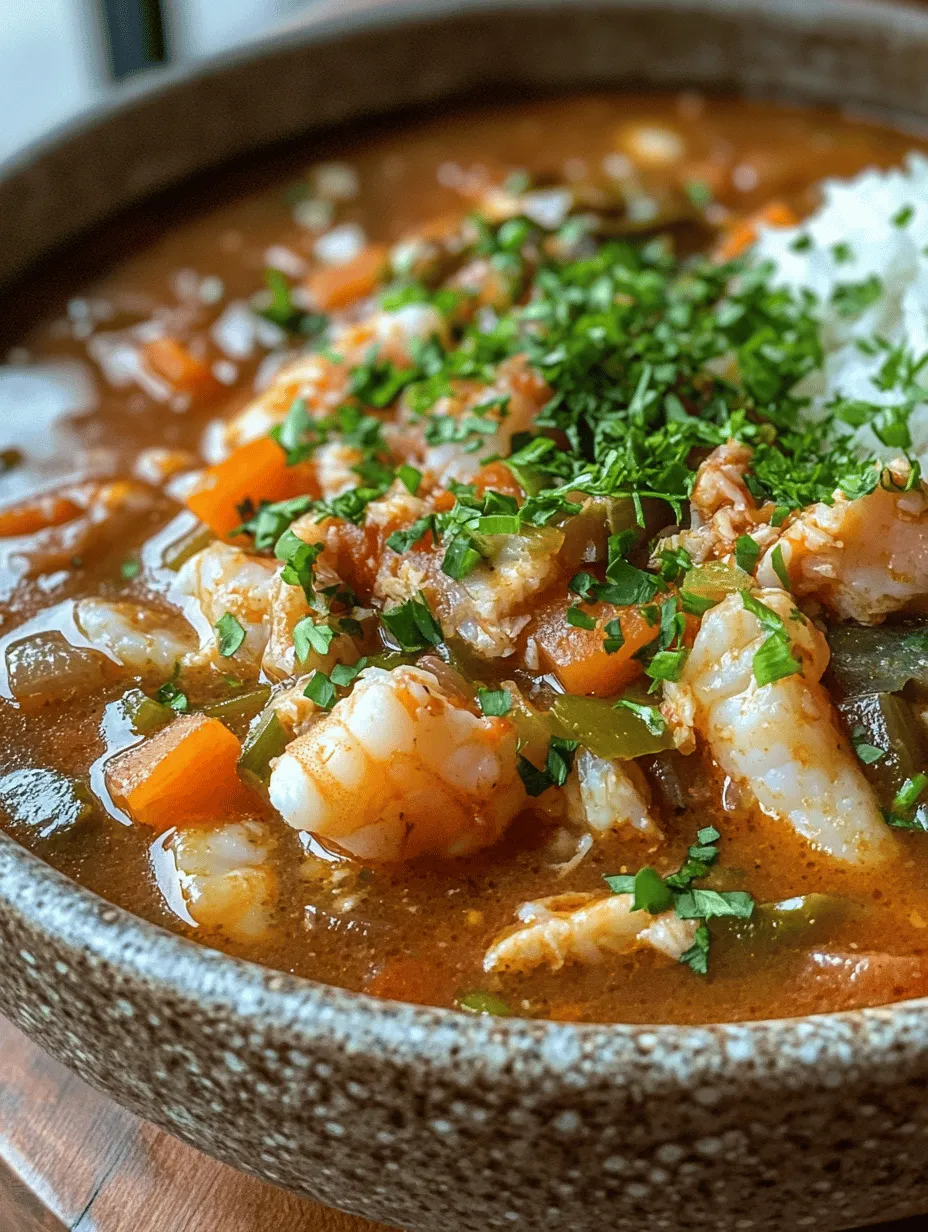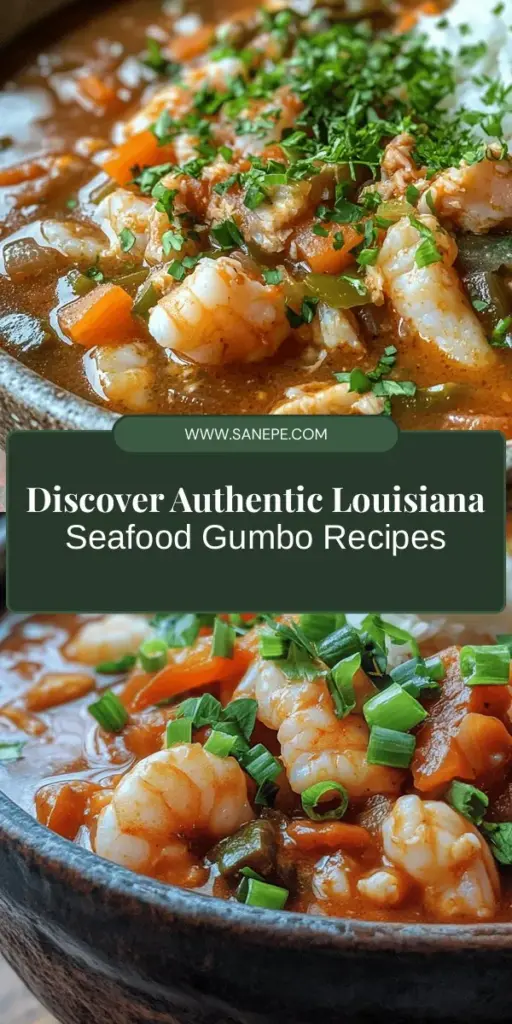Introduction
Louisiana seafood gumbo is more than just a dish; it’s a celebration of the rich culinary heritage of the Pelican State. This iconic stew weaves together a tapestry of flavors and textures that reflect the diverse cultural influences that have shaped Louisiana’s cuisine over centuries. From family gatherings to festive celebrations, gumbo holds a special place in the hearts of many Louisianans and food lovers alike.
At its core, gumbo is a hearty stew that showcases the coastal bounty of Louisiana, featuring an array of seafood and aromatic spices. Its origins are as complex as its flavor profile, drawing from African, French, and Spanish culinary traditions. This article will take you on a journey through the history of gumbo, highlight the significance of each ingredient, and provide you with a step-by-step guide to crafting an authentic Louisiana seafood gumbo that is as satisfying as it is delicious.
The History and Origin of Gumbo
The Cultural Roots of Gumbo
The origins of gumbo can be traced back to the early 18th century, with influences from various cultures converging in Louisiana. African slaves brought their culinary traditions, including the use of okra, which would become one of the defining ingredients of gumbo. The French settlers contributed the technique of making a roux—a mixture of flour and fat used as a thickening agent—and the Spanish introduced spices and cooking methods that would further enhance the depth of flavor.
As the dish evolved, it absorbed regional variations, with each community adding its unique twist. For instance, in New Orleans, gumbo often incorporates shellfish and a dark roux, while in Acadiana, the Cajun version may feature a lighter roux and more gamey meats. This adaptability has allowed gumbo to flourish, becoming a beloved staple of Louisiana cuisine that reflects the state’s diverse cultural landscape.
Key Ingredients and Their Significance
One of the standout features of gumbo is its ingredient list, which not only adds flavor but also tells a story of the region’s culinary heritage.
The Role of Okra in Gumbo
Okra is often recognized as a signature ingredient in gumbo, contributing a unique texture and natural thickening properties. This vegetable, which has its roots in African cuisine, helps to bind the stew together, enhancing its richness. While some variations of gumbo may omit okra, its presence is essential in traditional recipes.
Understanding the Importance of the Roux
The roux is the heart and soul of gumbo. This mixture of flour and fat, cooked until it reaches a deep brown color, imparts a nutty flavor and thickens the stew. Achieving the perfect roux requires patience and attention, as it can easily burn if not monitored closely. The color of the roux—ranging from blonde to dark brown—will influence the final flavor profile of the gumbo, making it a critical step in the cooking process.
The Cultural Significance of Seafood in Louisiana Cuisine
Louisiana is renowned for its abundant seafood, making it a natural choice for gumbo. The Gulf of Mexico provides a rich array of seafood options, including shrimp, crab, and fish, each adding its distinct flavor to the dish. Seafood not only enhances the taste of gumbo but also symbolizes the region’s connection to the water and its rich culinary traditions.
Understanding the Ingredients
Creating an authentic Louisiana seafood gumbo begins with selecting the right ingredients. Here’s a breakdown of the essential components that make this dish truly special.
The Essential Components of Louisiana Seafood Gumbo
Overview of the Main Ingredients
The foundation of any gumbo lies in its core ingredients, which typically include vegetable oil, flour, seafood stock, and a medley of vegetables. These ingredients come together to create a flavorful base that serves as the canvas for the addition of seafood and spices.
The Importance of Andouille Sausage in Adding Depth of Flavor
Andouille sausage, a smoked sausage with French roots, plays a crucial role in gumbo, contributing a smoky, spicy flavor that elevates the dish. The inclusion of andouille not only adds depth but also enhances the overall heartiness of the stew, making it a favorite among gumbo enthusiasts.
Fresh vs. Frozen Seafood: A Comparison
When it comes to seafood, freshness is key. While frozen seafood can be a convenient alternative, using fresh, locally sourced seafood will result in a more vibrant and flavorful gumbo. If you have access to fresh shrimp, crab, or fish, take advantage of that bounty. However, if fresh options are unavailable, ensure you choose high-quality frozen seafood to maintain the integrity of your dish.
Spices and Seasonings: The Heart of Gumbo
The flavors in gumbo are built through a careful balance of spices and seasonings, which come together to create a harmonious blend.
The Function of Cayenne Pepper, Thyme, and Bay Leaves in Flavoring
Cayenne pepper adds a kick of heat to gumbo, while thyme and bay leaves contribute earthy, aromatic notes. These spices are essential for creating the signature flavor profile that defines Louisiana gumbo. The beauty of this dish lies in its adaptability, allowing you to adjust spice levels according to your preference.
Balancing Spice Levels to Cater to Individual Preferences
One of the joys of making gumbo is the ability to customize it to your taste. For those who prefer a milder flavor, simply reduce the amount of cayenne pepper or omit it altogether. Conversely, if you crave more heat, feel free to add extra spices or hot sauce. The key is to taste as you go, ensuring that the flavors develop harmoniously.
Step-by-Step Guide to Making Louisiana Seafood Gumbo
Now that we’ve explored the rich history and essential ingredients of Louisiana seafood gumbo, it’s time to dive into the cooking process. The first step in creating this iconic dish is preparing the roux, which serves as the foundation of flavor.
Preparing the Roux: The Foundation of Flavor
1. Gather Your Ingredients: You will need equal parts vegetable oil and flour—typically about half a cup of each for a large batch of gumbo. Make sure to have your pot ready on the stove.
2. Heat the Oil: In a heavy-bottomed pot or Dutch oven, heat the vegetable oil over medium to medium-high heat. It’s important to use a heavy pot to ensure even heat distribution, which prevents the roux from burning.
3. Add the Flour: Once the oil is hot, gradually whisk in the flour. Stir constantly to combine the two ingredients. Use a wooden spoon or a whisk to keep the mixture smooth and prevent lumps from forming.
4. Cook the Roux: Continue to cook the roux, stirring frequently, for about 20 to 30 minutes. The goal is to achieve a deep brown color, similar to melted chocolate. As the roux cooks, it will change from a pale yellow to a golden brown, and finally to a rich, dark brown. Be patient and vigilant during this step, as the roux can easily go from perfect to burnt in seconds.
5. Aromas Will Emerge: As the roux darkens, you will notice a nutty aroma filling your kitchen. This is a sign that the roux is developing the flavor needed for a rich gumbo.
6. Remove from Heat: Once your roux has reached the desired color, remove it from the heat. Be careful, as the roux will be extremely hot.
In this first part of our journey to create an authentic Louisiana seafood gumbo, we’ve explored the historical significance, essential ingredients, and the crucial first step of preparing the roux. Stay tuned for the next section, where we will continue crafting this flavorful stew, combining the roux with aromatic vegetables, seafood, and spices to bring this beloved dish to life.

Tips for Avoiding Common Mistakes in Roux Preparation
Creating the perfect roux is a crucial foundation for an authentic Louisiana seafood gumbo. This mixture of flour and fat serves as the thickening agent and flavor base for your dish. However, many home cooks encounter challenges during this step. Here are some tips to avoid common mistakes while preparing your roux:
1. Choose the Right Fat: Traditionally, a blend of oils such as vegetable oil or a combination of butter and oil works best. Avoid using olive oil, as its lower smoke point can lead to burning.
2. Patience is Key: Cooking the roux requires low to medium heat. Rushing this process by increasing the heat can cause it to burn, resulting in a bitter taste. Stir frequently to ensure even cooking.
3. Color Matters: Aim for a dark brown color, which can take anywhere from 20-40 minutes. The darker the roux, the richer the flavor will be for your gumbo. A light roux works for other dishes, but for gumbo, you want a deep, chocolatey hue.
4. Avoid Clumping: If you notice clumps forming, resist the urge to add liquid immediately. Continue stirring until the roux is smooth and uniform before incorporating any stock or broth.
Incorporating Vegetables: Building Layers of Flavor
The “holy trinity” of Louisiana cooking—onions, bell peppers, and celery—forms the aromatic base of your gumbo. Here’s how to sauté them properly and enhance the flavor profile of your dish:
Best Practices for Sautéing the Holy Trinity
1. Preparation: Dice your onions, bell peppers, and celery into uniform pieces. This ensures even cooking and prevents some pieces from being overcooked while others remain raw.
2. Timing: Add the vegetables to the roux after it reaches the desired color. The residual heat from the roux will cook them gently, allowing their natural sugars to caramelize, which adds depth to the flavor.
3. Cooking Process: Sauté the holy trinity for about 5-7 minutes until they are soft and translucent. Stir frequently to prevent sticking and burning, which could alter the flavor of your gumbo.
The Role of Garlic and Its Timing in the Cooking Process
Garlic is a fantastic addition to your gumbo, but it should be added at the right moment to maximize its flavor:
1. Timing is Crucial: Minced garlic should be added after the holy trinity has softened. This prevents it from burning and turning bitter, which can ruin the dish.
2. Flavor Infusion: Sauté the garlic for about 1-2 minutes until fragrant. This brief cooking time allows the garlic’s oils to release, enriching the overall flavor of the gumbo.
Creating the Gumbo Base
Once your roux and vegetables are prepared, it’s time to create the delicious gumbo base. Here’s how to ensure a smooth transition into this crucial stage:
Techniques for Adding Stock and Tomatoes Without Lumps
1. Gradual Addition: When adding stock or broth, do so gradually while whisking continuously. This helps incorporate the roux smoothly into the liquid without forming lumps.
2. Temperature Considerations: Ensure your stock is warm before adding it to the roux mixture. Cold stock can cause the roux to seize up, resulting in a lumpy texture.
3. Tomato Incorporation: If you are adding diced tomatoes or tomato paste, mix them in with the stock rather than directly into the roux. This helps to evenly distribute the acidity and flavor.
The Importance of Simmering and How It Affects Flavor Development
Once the base is established, simmering is essential for developing the gumbo’s complex flavors:
1. Simmering Time: Allow your gumbo to simmer for at least 45 minutes to an hour. This slow cooking process melds the flavors, deepening the taste.
2. Flavor Extraction: As the gumbo simmers, the ingredients—especially spices and aromatics—release their flavors into the broth. This is critical for achieving a rich, well-rounded final dish.
3. Taste as You Go: Keep tasting your gumbo during the simmering process. Adjusting seasoning at this stage is much easier than trying to correct it later.
Adding the Seafood: Timing and Techniques
Incorporating seafood into your gumbo requires attention to timing, as different types of seafood have varying cooking times:
Best Practices for Incorporating Shrimp, Crab, and Okra
1. Order of Addition: Start with the seafood that takes longer to cook. Add crab meat first, allowing it to heat through for about 5-7 minutes.
2. Adding Shrimp: Next, add shrimp, which typically requires only 3-5 minutes to cook until they turn pink and opaque.
3. Okra Considerations: If using fresh or frozen okra, add it towards the end of the cooking time. Okra thickens the gumbo, so adding it too early can result in an overly thick consistency.
Understanding the Cooking Times for Different Seafood Types
1. Crab: Fresh crab meat can be added toward the end of cooking, as it is already cooked and only needs warming.
2. Shrimp: As mentioned, shrimp cooks quickly. Add it when your gumbo is just about done to ensure it doesn’t become rubbery.
3. Other Seafood: If you choose to include other seafood like fish or scallops, be sure to add them last, adjusting cooking time based on their thickness.
Final Touches: Balancing and Serving
The final touches can elevate your gumbo from good to exceptional. Here are some tips for balancing flavors and serving effectively:
Adjusting Seasoning and Enhancing Flavors with Worcestershire Sauce
1. Taste and Adjust: Before serving, taste your gumbo once more. Adjust seasoning with salt, black pepper, or additional Cajun seasoning as needed.
2. Worcestershire Sauce: A splash of Worcestershire sauce can enhance umami flavors and add a subtle depth. Start with a teaspoon and adjust according to your preference.
Presentation Tips for Serving Gumbo Over Rice
1. Rice Preparation: Cook your rice separately to ensure it’s fluffy. A long-grain variety like jasmine or basmati works well.
2. Serving Method: Serve the gumbo in bowls with a scoop of rice in the center. This not only looks appealing but allows the diner to mix the gumbo and rice at their discretion.
Serving Suggestions and Pairings
To create a well-rounded meal, consider these serving suggestions and pairings that will complement your Louisiana seafood gumbo:
Ideal Side Dishes and Accompaniments for a Complete Meal
1. Cornbread: A classic Southern side, cornbread pairs beautifully with gumbo. Its slightly sweet flavor balances the savory spices of the dish.
2. Coleslaw: A cool, tangy coleslaw can provide a refreshing contrast to the warm, rich flavors of the gumbo.
3. French Bread: Serve warm slices of French bread or baguette for a perfect option to soak up the delicious broth.
Recommended Beverages to Enhance the Dining Experience
1. Iced Tea: Sweetened or unsweetened iced tea is a Southern staple that refreshes and pairs well with the bold flavors of gumbo.
2. Beer: A light lager or a malty amber ale can complement the spices in the gumbo without overpowering them.
3. Wine: If you prefer wine, a crisp white like Sauvignon Blanc or a slightly fruity red like Zinfandel can enhance your meal.
Garnishing Your Gumbo
Presentation elevates the dining experience, and garnishing is a simple yet effective way to do this:
The Importance of Fresh Herbs in Presentation and Flavor
1. Fresh Parsley: A sprinkle of chopped fresh parsley adds a pop of color and freshness to your gumbo.
2. Green Onions: Sliced green onions not only enhance the visual appeal but also contribute a mild onion flavor.
Variations on Garnishes: Exploring Different Regional Styles
1. Filé Powder: Traditional in some regions, a sprinkle of filé powder (ground sassafras leaves) can enhance flavor and thicken the gumbo slightly.
2. Hot Sauce: Offer a selection of hot sauces on the side for guests to customize their heat level. Different regions have their own favorite brands, so consider a variety.
Conclusion
Louisiana Seafood Gumbo is more than just a meal; it is a celebration of culture, history, and culinary artistry. By following this detailed guide, you can recreate a dish that not only satisfies the palate but also connects you to the rich traditions of Louisiana cooking. Whether served at a family gathering or enjoyed on a quiet evening, this gumbo is sure to warm hearts and homes alike. Embrace the process, enjoy the flavors, and share the joy of this classic dish with others. The art of gumbo-making is a journey filled with love, tradition, and a touch of personal flair—so get cooking and indulge in this delicious experience!


